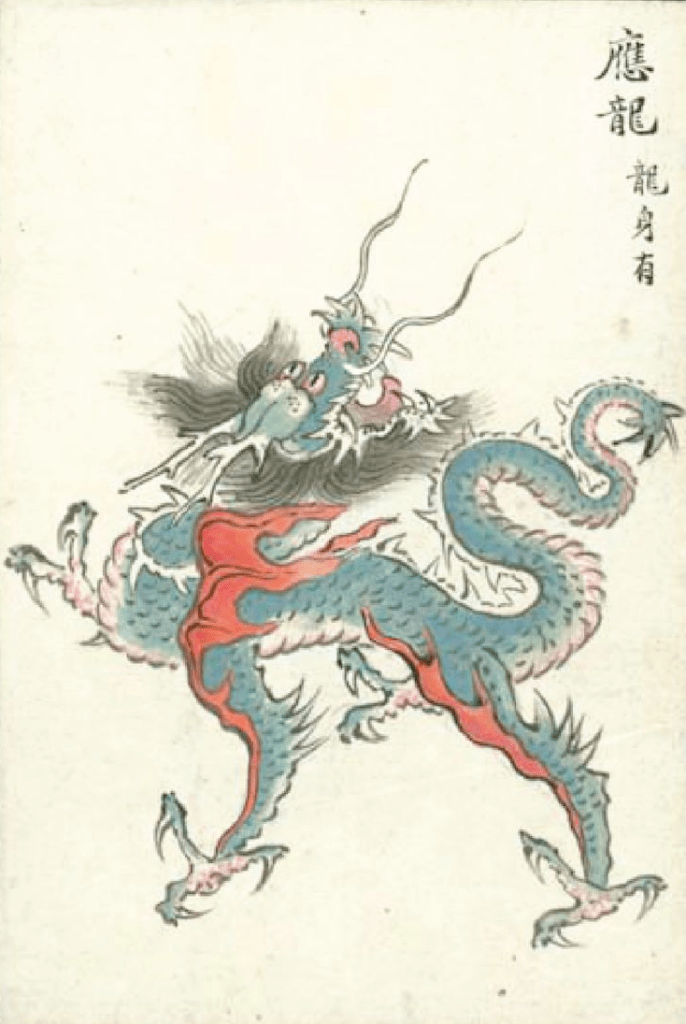
Yinglong/應龍, also known as Huanglong (Yellow Dragon/黄龙), Feilong (Flying Dragon/飞龙), or Gengchen, is a deity in ancient Chinese mythology that embodies the roles of creator, destroyer, and preserver. Yinglong also appears as a war god and was a great general serving under the Yellow Emperor.
Yinglong is associated with the central position among the Five Directions, representing the essence of the Central Seven Mansions. It is associated with the Earth element and is considered the god of clouds, rain, thunder, and rivers. Yinglong is also revered as a celestial dragon, the consort of the heavenly deity Taiyi, known as the dragon that responds to celestial commands and assists in governing the realm.
Legends of Yinglong
Yinglong resided in the northeast, at the Xiong Li Tu Qiu mountain. He defeated Chi You and Kuafu, unable to ascend to heaven afterwards, thus leading to droughts. Only by adopting Yinglong’s form could rain be summoned.
《山海经 · 大荒东经》
大荒东北隅中,有山名曰凶犁土丘。应龙处南极,杀蚩尤与夸父,不得复上,故下数旱,旱而为应龙之状,乃得大雨
After defeating Chi You and Kuafu, Yinglong was sent to the south, resulting in heavy rains in that region.
Chi You waged war against the Yellow Emperor, who then commanded Yinglong to attack in Ji Zhou’s fields. Yinglong summoned water, and despite Chi You’s plea to the Wind Lord and Rain Master for a great storm, the Yellow Emperor’s intervention with Tian Nu (Heavenly Maiden) stopped the rain, leading to Chi You’s defeat.
《山海经 · 大荒北经》
应龙已杀蚩尤,又杀夸父,乃去南方处之,故南方多雨
蚩尤作兵伐黄帝,黄帝乃令应龙攻之冀州之野。应龙畜水,蚩尤请风伯雨师纵大风雨,黄帝乃下天女曰魃,雨止,遂杀蚩尤
The Yellow Emperor ordered Yinglong to battle Chi You, where Yinglong exhibited the strength of four beasts – the tiger, leopard, bear, and ifco.
《宋书·福瑞志》
应龙攻蚩尤,战虎、豹、熊、罴四兽之力。
Origins of Yinglong
In on opinion, Yinglong is believed to be the offspring of Mao Du/毛犊 (a mythical beast) and Yu Jia/羽嘉(a mythical dragon).
Mao Du is the ancestor of Yinglong, Yinglong is the ancestor of Jian Ma, Jian Ma is the ancestor of Qilin, and Qilin is the ancestor of all furred beasts. Thus, Mao Du is considered the progenitor of all wild beasts with fur, resembling Yinglong but with longer fur. Yu Jia is the ancestor of the flying dragon, which is the ancestor of the phoenix. The phoenix then gave birth to the luan bird, the ancestor of all feathered birds. Yinglong is the offspring of Mao Du and Yu Jia, inheriting Mao Du’s appearance and resembling a dragon more closely.
《淮南子·墬形训》
毛犊生应龙,应龙生建马,建马生麒麟,麒麟生庶兽,凡毛者,生于庶兽。
《镡津文集》
羽嘉生应龙,应龙生凤凰
In another opinion, It’s believed that after 500 years, a Hui/虺 (a kind of snake) transforms into a Jiao (lesser dragon), and after a thousand years, into a dragon. After another 500 years, the dragon becomes a Jiao Long (horned dragon), and after a thousand years, it turns into Yinglong.
Hui is described as a venomous snake living in water, with a large head and slender neck.
《述异记》
水虺五百年化为蛟,蛟千年化为龙,龙五百年为角龙,千年为应龙
《墨客挥犀》
蛟之状如蛇,其首如虎,长者至数丈,多居于溪潭石穴下,声如牛鸣。倘蛟看见岸边或溪谷之行人,即以口中之腥涎绕之,使人坠水,即于腋下吮其血,直至血尽方止
Image of Yinglong
Yinglong is often depicted as a dragon with a coiled or serpentine body and wings, symbolizing the fusion of dragon and phoenix totems.
Dragons with scales are called Jiao Long, with wings are called Yinglong, with horns are called Qiu Long, and without horns are called Chi Long.
《广雅》
有鳞曰蛟龙,有翼曰应龙,有角曰虬龙,无角曰螭龙
Yinglong patterns, depicting winged dragons, were popular during the Ming dynasty and appeared on various artifacts like bronze ware, jade carvings, and silk paintings. The earliest Yinglong artifacts, dating back 7400 years, were discovered in Inner Mongolia.
Abilities of Yinglong
Yinglong had the power to control the weather, regulate rainfall, and alleviate floods. It could also open up mountains and rivers. Known for defeating Chi You and Kuafu, Yinglong had the ability to stir oceans, create clouds, and change its form and size. It was revered in folk beliefs as a guardian of agriculture and water management, ensuring peace and prosperity.
As Yinglong soars, clouds and mist rise tumultuously in its wake. The wind howls fiercely, resonating unbidden through the vast sky, moving all things naturally as it passes.
《新唐书》
应龙之翔,云雾滃然而从,震风薄怒,万空不约而号,物有自然相动耳。
应龙潜于潢污,鱼鼋媟之,不睹其能奋灵德,合风云,超忽荒,而躆颢苍也。故夫泥蟠而天飞者,应龙之神也
《汉书》
应龙潜于潢污,鱼鼋媟之,不睹其能奋灵德,合风云,超忽荒,而躆颢苍也。故夫泥蟠而天飞者,应龙之神也
The Yinglong is revered for its ability to contract and expand, and the Phoenix is esteemed for its auspicious call. Why then must they hide their form beyond the heavens or conceal their scales in the deep abyss?
《三国志·吴书》
夫应龙以屈伸为神,凤皇以嘉鸣为贵,何必隐形于天外,潜鳞于重渊者哉?
When Yu controlled the waters, Yinglong used its tail to draw on the earth, guiding the paths for the waters to flow.
《太平广记》
禹治水,应龙以尾画地,导决水之所出
“Auspicious horses open vistas, bringing glory to future generations; Yinglong breaks the ground, providing land for homes in distant years.
《册府元龟》
瑞马开图,发荣光于远代;应龙辟壤,致宅土于遐年
Remnants of Yinglong
In the Tang Dynasty, an “Yinglong City” was established in the Western Sea. In Qinghai Province, on the Heart Mountain of Qinghai Lake, the ancient site of Yinglong City from the Tang era still exists and was designated a provincial-level cultural heritage site in 1988.

Comments are closed.